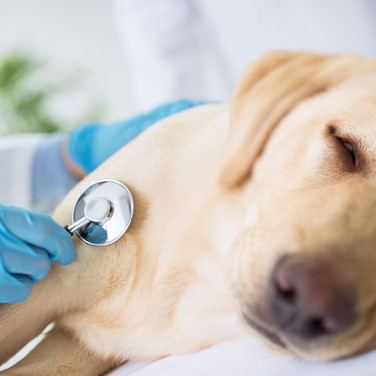DISEASES
Atrial Septal Defect (ASD) in Dogs - Symptoms and Treatment Methods
페이지 정보
본문


What is atrial septal defect (ASD) in dogs?
An atrial septal defect is an uncommon congenital heart disease in which a portion of the middle wall (septum) between the left and right atria is present with a hole at birth. Blood flows through the defect between the left and right atria, which should be kept separately, causing oxygen-rich blood to flow back into the lungs instead of the rest of the body.
In the early stages of an atrial septal defect, blood typically moves from the left atrium to the right atrium, causing an excess of blood to enter the right atrium, right ventricle, and blood vessels of the lungs. This abnormal blood flow increases pressure and leads to pulmonary hypertension in dogs with ASD. Symptoms such as coughing and shortness of breath may occur, as the defect progresses, and fluid build-up and signs of right heart failure may be present.
As the pressure in the right heart increases due to the defect, shunting from the right to left heart can occur, causing symptoms of cyanosis. In most cases, minor atrial septal defects in dogs can live a normal lifespan with proper treatment, but severe cases of ASD can cause life-long problems and may be accompanied by other heart abnormalities.
Causes of atrial septal defects in dogs
An atrial septal defect is a congenital anomaly in which a puppy is born with a hole in the septum that separates the left and right atria. The underlying cause is still unknown. In general, an atrial septal defect is a congenital disease that is more common in cats than in dogs. It accounts for only 0.7% of all congenital heart defects in canines.
It can occur in any breed of dog, but known breeds that are predisposed to congenital heart defects include:
- Boxers
- Doberman Pinschers
- Old English Sheepdogs
- Samoyeds
Symptoms of canine atrial septal defects (ASD)
If the defect of the atrial septum is not large, a heart murmur heard through auscultation may be the only symptom observed by a veterinarian. A small hole in the atrial septum in a pet can appear asymptomatic; however, additional abnormal symptoms may appear if the defect progresses and grows larger.
Common symptoms of an atrial septal defect in dogs include:
- Heart murmur
- Exercise intolerance
- Fainting
- Shortness of breath
- Coughing
-
Cyanosis
Tongue or mucous membranes will appear blue as a sign of cyanosis. - Ascites or fluid buildup in the lungs
Risk of atrial septal defects in dogs and when to see a vet
The severity of atrial septal defect depends on the size and location of the hole.If symptoms such as rapid fatigue, exercise intolerance, coughing, or fainting appear during exercise, play, or excited situations, it is recommended that you visit a hospital for an accurate examination. There is a possibility of other heart diseases in addition to a pet’s atrial septal defect.
In any case, if breathing difficulties or symptoms of cyanosis appear, you should visit the hospital immediately. If an atrial septal defect is confirmed, the siblings and parents should also get screened for any ASD malformations.
How to deal with atrial septal defect in dogs at home
Atrial septal defect in dogs typically requires professional treatment depending on the severity and symptoms appearing. It is recommended to refrain from excessive exercise or activity at home if symptoms of ASD do occur.

How are atrial septal defects in dogs diagnosed at the vet
If a dog is suspected of having an atrial septal defect, the veterinarian will ask the guardian questions about the pet's condition. Based on the answers, they will conduct the necessary tests and create a treatment plan accordingly.
Your veterinarian may ask questions such as:
- Has your dog shown any symptoms of exercise intolerance, fainting, or cyanosis?
- Does your dog have symptoms of shortness of breath or coughing?
- Is your dog’s energy level normal?
- When did any of the above-mentioned symptoms appear?
Based on your answers, the following tests can be performed for an accurate diagnosis.
-
Physical examination
Auscultation is important when an individual is experiencing symptoms related to the heart. The presence of a heart murmur can be confirmed through auscultation, and physical examination can be used to check for the presence of cyanosis and ascites.
-
Blood and urine tests
Check for abnormalities in the body, including polycythemia.
-
Chest X-ray
Dilatation of the right atrium, right ventricle, and pulmonary vessels can be observed.
-
Echocardiography
Atrial septal defects can be directly observed through an echocardiogram. The atrial septal defect’s dilation and the blood flow of the right atrium and right ventricle can be checked. Arrhythmia can also be identified.
ASD in dogs can be classified according to the location of the defect as follows:
-
Ostium primum defect:
There is a hole below the atrial septum.
-
Ostium secundum defect:
The most common type of defect in the atrial septum, the defect exists near the fossa ovalis.
-
Sinus venosus defect: There is a defect in the anterior and upper part of the foramen ovale
Treatment for atrial septal defect in dogs
An atrial septal defect may not require treatment if the defect is small. A dog with a minor atrial septal defect may live their whole life without any symptoms, and their condition may be discovered by chance as they get older. Treatment for atrial septal defect can vary, depending on the location and size of the defect, as well as the size and pressure of the heart. If the size of the defect is large, a treatment plan will be established through consultation with a veterinarian, based on test results.
Treatment plan for ASD in dogs can include:
-
Medication management
Drug treatment for atrial septal defect is typically focused on reducing symptoms and preventing the condition from worsening, rather than treating the defect itself. The goal is to prevent the development of clinical symptoms by using drugs to address the hemodynamic and structural changes that occur in the heart due to the defect.
-
Interventional therapy
In the case of an ostium secundum atrial septal defect, an interventional procedure can be performed using a catheter to access the heart through the blood vessels, to close the defect.
-
Surgical correction
The defect can be corrected through surgery effectively, but it is expensive and has a high mortality rate.
Prognosis of an atrial septal defect in dogs
The prognosis of an atrial septal defect depends on the patient's condition, the size of the defect, and changes in the heart. In cases where interventional procedures are used, the defect may be completely corrected after surgery, and the patient may be able to live a normal lifespan. However, in cases where surgical correction is required, the procedure is typically performed when the size of the defect is fairly large. The mortality rate of surgery is higher in these cases, and because the size of the defect is larger, many patients have an overall poor prognosis.
Prevention of atrial septal defect in dogs
Since atrial septal defect is a congenital disease present from birth, it is impossible to prevent it. The best course of action is to detect and manage heart problems early through regular examinations. If your pet has a genetic disease such as an atrial septal defect, it is recommended that the dog does not breed to avoid passing it on to their offspring.
Find out more about your dog’s disease or symptoms in the Buddydoc Library!

The Buddydoc library is filled with everything you’d want to know about each symptom and disease your pet may experience. If you would like to find out more about the causes, signs, treatments, preventions, and more for your dog’s disease. Try out the Buddydoc app and search your pet’s symptom or disease in the Buddydoc library.












